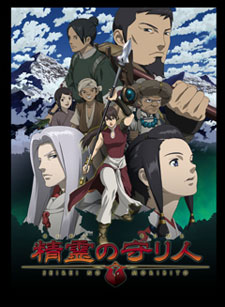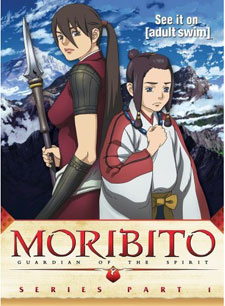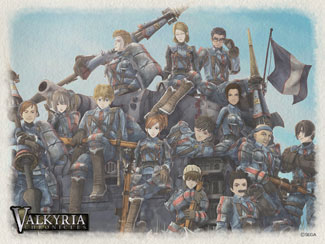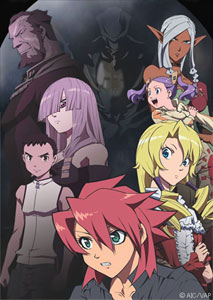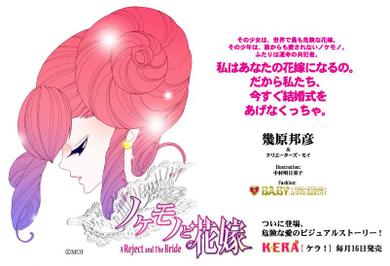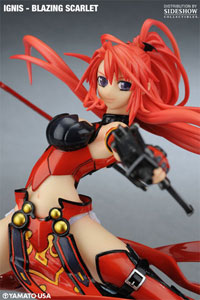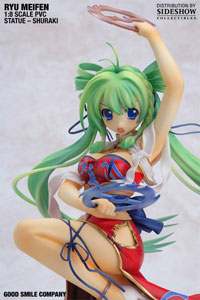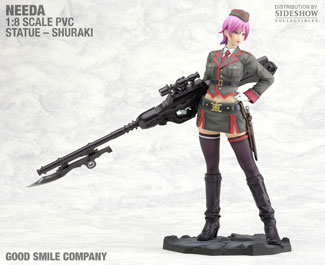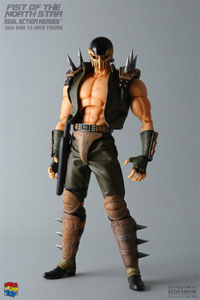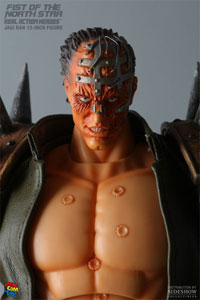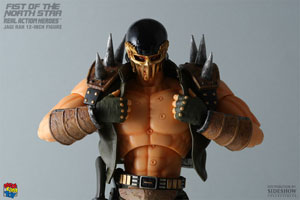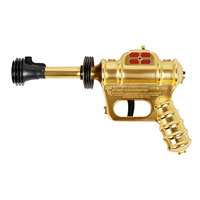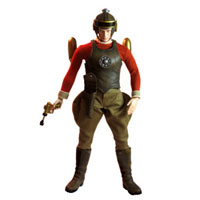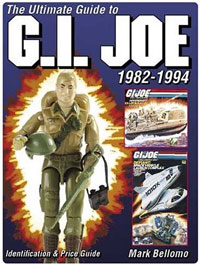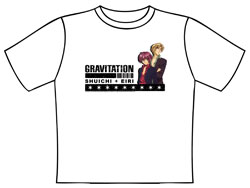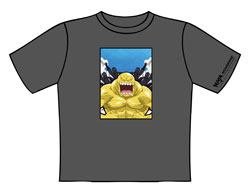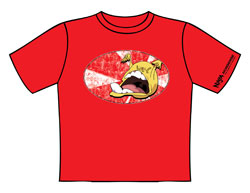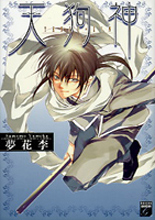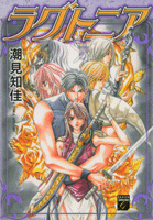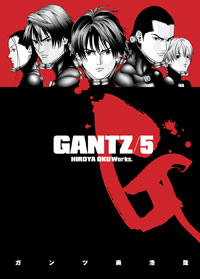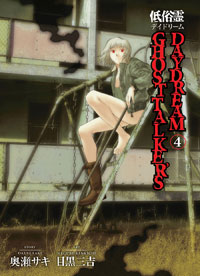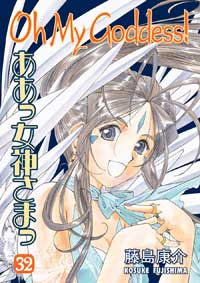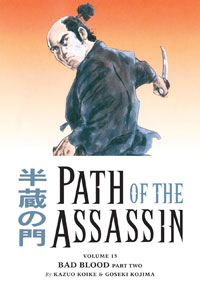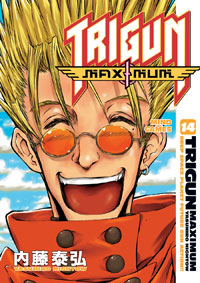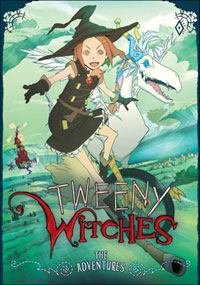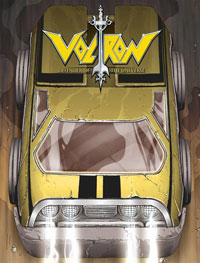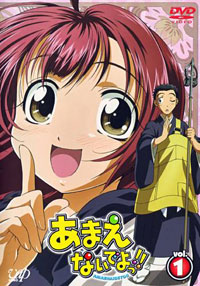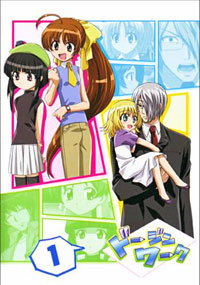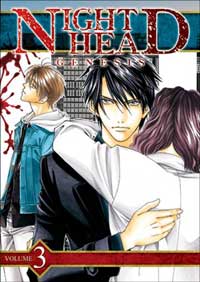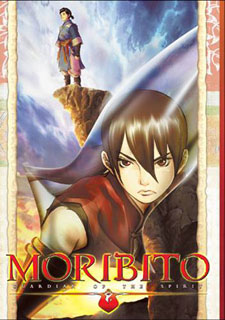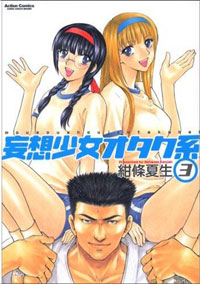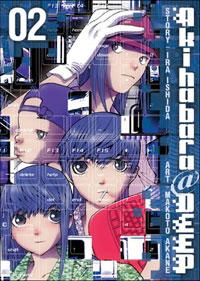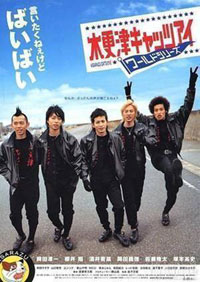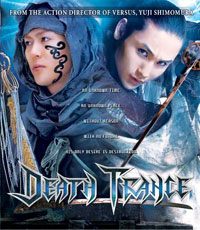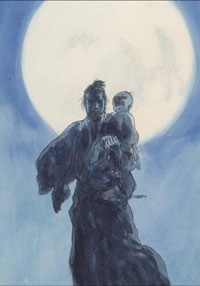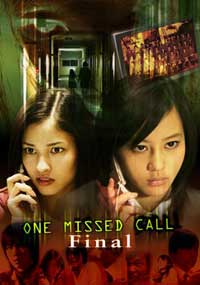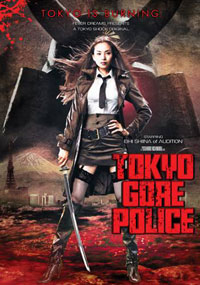 Logo handmade by Bannister
Column by Scott Green
Logo handmade by Bannister
Column by Scott Green
Win a Copy of Bat-Manga!
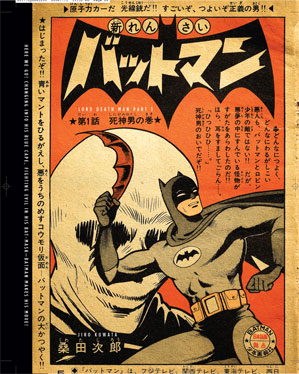

Eight Years...
Mid-November marks the anniversary of AICN Anime, the foundations of which started on the site in 2000. For those interested in a brief history, check out the one that I wrote for the fiftieth. It's been quite the ride. AICN Anime, the source for anime coverage that hasn't faded... yet...
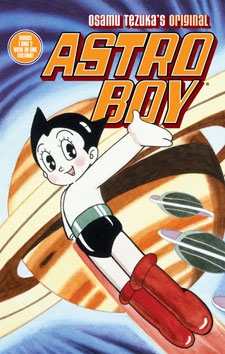
Manga Spotlight: Astro Boy "1 and 2" By Osamu Tezuka Released by Dark Horse
Along with Lone Wolf and Cub, the 2002-2004 release of the 23 volumes of "God of Manga" Osamu Tezuka's Astro Boy was one of Dark Horse's colossal manga projects from the early part of the decade. These invaluable contributions to manga in North America are still available (it's easier to find some volumes of Lone Wolf now than it was when I was first collecting it in 2000), but with the Imagi CG animated Astro Boy scheduled for 2009, the publisher has started packaging double volumes of the seminal manga series, starting with volumes 1 and 2 combined into one 4 1/2" x 6 3/4", 424 page book this September. Astro Boy is the Zeus of manga and anime. He may have been preceded by Titans in both media, but Astro Boy would overthrow those forbearers and lay out the governing template. Frederik L. Schodt's The Astro Boy Essays quotes Tezuka in saying that the early 1950's marked a "manga renaissance" ushered in by a confluence of intellectual freedom and the establishment of manga as a mass medium. With audiences looking for something fresh, like a sci-fi story informed by western animation, raised by Tezuka's brilliant storytelling, Astro Boy took hold. With him came Tezuka's vision for manga, including a cinematic visual approach, an expansive reach in influences and a willingness to mix heavy and light themes. A decade later, when Tezuka established Mushi Productions to create an Astro Boy anime, he similarly laid out a creative and economic model for how televised anime would be produced. I'd hazard to guess that an anime/manga fan, or a pop culture enthusiast in general, would be able to identify an image of Astro Boy. That's probably more foreknowledge than is needed to understand most of his stories. If you can't intuit that he's a powerful robot child, a character is bound to make the point shortly. About a quarter of the origin story offered in this volume consists of the background to Tezuka's world of robots... how the Native American scientist Professor C. Wakuchia revolutionized the electronic brain in 1978, how Japanese Professor Sarumane incorporated the brain into the first humanoid robot in 1983 and how Professor James Dalton created a plastic based artificial skin. Responding to the ever increasing population of robots, a bill of laws was drafted, laying out the governing ordinances from article 1: robots exist to make people happy to article 13: robots shall not kill or injure humans. The Astro Boy Essays lists the kill or injure measure as #2 (Tezuka's handling of Astro Boy never really emphasized consistency) and translates #1 as "robots are created to serve mankind." There's something about the manga translation (also by Schodt) that gets to me, especially the "happy" part. It reads like a perversion of the inalienable rights of the United States Declaration of Independence. If humanity was created to stride to find happiness, robots were created by humanity to subserviently labor towards humanity's happiness. While Tezuka was generally metered about his involvement with specific politics, politics from a moral perspective shaded his works. With an authorial voice brisling at injustice, Astro Boy's depictions of the relationships between humans and robots serve as an undisguised metaphor for the struggle for civil rights. In light of recent history, the collection's "His Highness Deadcross," concerning the first elected robot president, makes for an especially charged story. From a crucifixion to a subverted leader, this is more unsettling than the grievous violence of something like . To a large extent, Astro Boy stories are atomic. Like episodic programming, unless a reoccurring character is introduced, the narrative begins and ends within the story. As such, Astro is free of his origin as soon as the story ends. Themes persist story to story, but specific manifestations of those themes don't . In 2003, Tobio was speeding down the street in his hover car, when he lost control and crash head long into a truck. The boy death launches his father into a disastrous psychological arc. In the midst of a fit of grief Dr Tenma is struck with an overwhelming impulse to create a robot in the image of Tobio. The mania stays with Tenma, who commits the resources of the Ministry of Science towards realizing his dangerous vision of an advanced robotic surrogate. "A single flaw in the design of these circuits and not only this computer but this whole lab will be blown to smithereens!" The results are a robot boy whose "pleasure circuits" light up as he learns and spends time with his father/creator. "After a while Dr. Tenma's mental condition improved, and both he and Tobio seemed very happy. But Tenma realized he had made a terrible mistake in the design of his robot son. No matter how much time passed, Tobio did not grow." In response, Tenma casts out the "freak" "doll." Tobio is stripped of his clothes and sold to a circus where he is redubbed "Astro." However, at the circus, Astro is spotted by Professor Ochanomizu, who "realized 'Astro' was not an ordinary robot." Freeing Astro and promising to be 'like a father,' Ochanomizu teaches Astro to use his special abilities like flight, acute sense, and rear mounted machine guns. And so, "The robot once known as Tobio was reborn and his new name was Astro Boy". (Which begs the Happy Feet question - if the penguins couldn't dance, were they still worth saving? If Astro Boy was an "ordinary robot," would Ochanomizu have still been moved by his plight?") The Astro Boy Essays detail how Tezuka went back and forth with Shonen magazine editor Takeshi Kanai about the possibilities for a robotic hero following "Ambassador Atom," an Astro Boy prototype towards which Tezuka felt creatively ambivalent, but to which reader reacted strongly. Kanai suggested "Instead of making him a character that takes off his arms and legs for gags, make him a robot with emotions, who laughs, cries, and gets angry when he senses justice!" Astro Boy would appear to sacrifice his existence a number of times since his creation, but inevitably, he'll always reappear as the determined child flying out of the panel in the last image of that origin story. While the concept of a robot boy who comes to life has often been compared to Pinocchio, there is also something of Peter Pan in Astro Boy. Part of what is appealing about the character is that no matter what he experiences, whether it is wonder or tragedy, he's always a child discovering for the first time. There's nothing jaded or knowing in the emotive expression that Tezuka draws across the character's face from panel to panel. These collected Astro Boy stories feature retrospective introduction presented by a manga version of Tezuka himself. As Tezuka generally drew himself, here's a character in a beret, with a spotted, bulbous nose, who is often frowning if not outright scowling. Not only has Tezuka stepped in to provide context and insight into the stories, he's set himself up as a complement and sometimes counter point to Astro Boy. Where Astro is an innocent, reacting from the heart, Tezuka is a cantankerous artist, lighting up a cigarette and speaking about his experience. He decries how Astro Boy was localized for America, particularly the hypocrisy. Speaking about objections to a scene of a dog being operated upon: "I frankly don't think that was fair. After all, foreigners often shoot and eat animals in cruel and grotesque ways." (pointing to a pig with an apple stuffed in its mouth) "... and all the wild animals white people shoot for sport... and despite that, people in England have the nerve to spread false rumors about Japanese people eating dogs!" On an American critic calling Astro boy a "murderer" for destroying other robots "Americans were so sensitive about scenes of violence in fantasy then, but at the same time, they didn't have much trouble going over to South East Asia and killing people.." He's self critical... "the stories in the long Astro Boy manga are often of uneven quality, and frankly, I don't care for some of them that much." And he also gives away the trick, explaining the use of four fingered character and how the two spikes in Astro's hair look the same, no matter the angle from which the character is viewed. This is essential Tezuka in that he's not talking down to his audience. As endearing as Astro might be, he exists in a world were people are flawed, sometimes terribly so. Astro might not recall that lesson from story to story, but in these collections Tezuka is present to place the imprint of experience. Dark Horse has localized the 23 volume Sunday Comics release of the series. This version of Astro Boy is editorially ordered. As such, it is composed to produce 23 volumes of Astro Boy manga, rather than arranged in order of publication, or chronologically, or by theme. Volume 1 starts with the brief 1975 version of Astro Boy's origin rather than the first story from 1951, then, the combined volumes 1 and 2 collects 5 other stories from the early 60's. Tezuka did not apply a strict continuity to Astro Boy as a whole, and he was given to going back and revising Astro's origin, so this is not necessarily an inappropriate approach to the work. However, it might cause some minor jolts. In particular, an appearance by Astro's parents (not Dr. Tenma) his sister Uran and brother Cobalt (aka Jetto) might make for a bit of a speed bump when it happens before any of those characters are introduced. There are specific Astro Boy stories that I've gone back to repeatedly, "The Angel of Vietnam" and "The Greatest Robot on Earth" foremost among them. Yet, it's been years since I've read a volume of Astro Boy cover to cover. Though I did just that for this release, I don't recommend doing the same. The first of the stories after the origin is the 160 page "Hot Dog Corp." One of the characters from Astro Boy who appears frequently throughout Tezuka's body of work is the fiery, mustachioed Shunsaku Ban. In Astro Boy, he's Astro's teacher. Elsewhere, he's a gruff amateur detective or blue collar personality. The Hot Dog Corp starts with Ban's dog being kidnapped by a Russian-ish duchess, whose scientist henchman transplants the dog's brain into a humanoid cyborg body. Scene by scene, the story is bold and exciting. It has stark drama. Tableaus such as the titular cyborg corp scrambling to launch their flying sorcers in the a midst snow storm offer classic sci-fi excitement. The problem is that this is an eventful story driven by authorial whim. Read a chapter at a time, the tall tale's fluidity would be engaging. Read too many chapters at a go, and it becomes tiring. Yes, that's applying a modern standard toward a manga that was laying the foundation for modern manga, but if you go into Astro Boy trying to read it like you might any other manga, you might come away not liking it. My recommendation is to read a few pages of the manga at a time and try to appreciate what's on those pages rather than try to run through the whole volume and process it in one block.

Manga Preview Pluto: Urasawa x Tezuka 001 by Naoki Urasawa To be released by VIZ Media February 17, 2009
Naoki Urasawa's Pluto is a Blade Runner re-imagining of Astro Boy, not in terms of plot or environment, but in terms of tension. While the manga deals with a detective trying to find the truth behind two, specific, potentially incendiary deaths, it's not just one troubled individual in the spotlight with a dimmed, inactive world around him. Whatever that detective sees, whether it is a mundane day to day struggle, evidence of a haunting past or an acute tragedy, it does not go away when he leaves the room. The consequences of those deaths may turn out to be apocalyptic, and the worst may be averted, but even then, Pluto projects a tomorrow which is likely going to be trying for all involved. Looking into a disaster plowing through a forest of social problems, this story is palpably stressful. Of all the reaction manga can evoke, few are as likely to cause you to rub your temples as Pluto. I don't know if "not maudlin, but genuinely sad" is a selling point for manga, but in terms of substantial sci-fi, I couldn't recommend Pluto any more strongly. As translated by Frederick L. Schodt in the Dark Horse release of Astro Boy, Osamu Tezuka's laws of robotics start with article 1: Robots exist to make people happy and end with article 13: Robots shall not injure or kill humans. In Turn, Pluto starts with two murders: Montblanc, the beloved robot of the Swiss Forestry service, veteran of the 39th Central Asian War, and poet and Bernard Lanke, a member of the movement to preserve the robot laws with a reputation for attracting enemies. Law 13 is evidently fundamental to Pluto's murder mystery, but law 1 seems equally essential. When I was studying for a BS in computer science, there was a junior year writing requirement. I forget the course title, but it had something to do with technology ethics or principles. So, in addition to learning tech writing, we were supposed to produce written responses to issues like piracy, privacy, life threatening software glitches, the intersections between social problems and technology and the like. While there were no Pollyannas in the class, there was a prevailing sentiment that there was a technological solution to most problems. The trick was to find that solution. I still see that idea around, and not just in the computer science/software field. We're looking for the right technology to save the auto industry, to protect the environment, to fix the economy... Pluto asks, what if we had what we thought we needed? What would things look like if we had everything that sci-fi of the 50's and 60's promised us? What if there were geniuses who could push artificial intelligence to the point where those systems were scientifically proven to possess subconsciousness? The manga seems defined by its sadness. Despite the hover cars and servant robots, humans seem to be of the same disposition that we were at the point at which the manga was written (2003). And, with talk of "weapons of mass destruction," they seem to be engaged in the same mistakes. On the other hand, between fulfilling their functions, contending with both casual and outright bigotry and largely being denied outlets for what could be thought of as their humanity, the robots of the manga look like they’re bearing Atlus' burden. Stripped of how Urasawa actually represents Pluto, many of its scenes verge on being laughable. A detective informs what is basically Rosie, the maid from the Jetsons that her husband Robbie, the police robot was destroyed in the line of duty. A Hannibal Lecter exchange is enacted with a heap of what looks like the robot that attends Luke Skywalker when he gets battered in Empire Strikes Back slotted in for the killer. In the Rosie case, Urasawa illustrates a figure trying to figure out what to do with herself to deal with her grief. She has routines, such as fixing tea, but her ability to express her emotion fails her as she stands with a cup of tea in each hand. She is able to draw a relationship to other experiences she has had and state her sorrow eloquently "I work as a made for a family. And they have a little boy. A human boy of course. Before the boy was born the family adopted a pet dog... the boy and the dog were fond of each other. But then the dog died. The little boy cried and cried for days. I tried my best to comfort him.. but only now do I understand how he must have felt." The image, as well as its implications concerning the world of robots and the less speculative human condition are heartbreaking. One of the classic, memorable stories in Osamu Tezuka's Astro Boy is 1964's "The Greatest Robot on Earth," also known as "The World Strongest Robot" (published in volume 3 of Dark Horse's release of the series, unfortunately, the only volume I can't find from my collection at the moment). Filling a volume of manga, and running two episodes in the 1963 and 1980 anime incarnations, it's one of the longer Astro Boy stories. Generally, the longer Astro Boy stories find their length by twisting and developing in unexpected directions. In contrast, The Greatest Robot on Earth is obviously a big one from its inception, and its premise enables it to work like a modern graphic novel narrative. A power hungry Sultan commissions the creation of the robot Pluto and sends the million horse power titan out into the world with the mission to destroy the seven most powerful robots, thereby commanding a spot as the king of all robots. With Pluto, Astro and six other super-powered robots battling across the globe and with heartfelt exchanges between Astro, Pluto and Astro's sister Uran, it's both a perennial favorite and one of the Astro Boy stories with the most potential to capture a new reader. One of the seven robots was the gold, "Zeronium" plated detective known as Gesicht (Zeron in the dub of the 1980 anime), who took up the mission of apprehending Pluto and determining his motives. Despite Gesicht's intellect and robotic abilities, a fight between the two ended tragically for Gesicht. Tezuka's stories depicted robots that looked human, and there were cases where humans could be mistaken for robots and vice versa. While the Gesicht of the Greatest Robot on Earth was a golden figure with gadgets protruding from his chest, Pluto's Gesicht can pass for human. And like a human, he is haunted by nightmares, exhaustion, the fear that he is an inadequate husband and inadequate to the task at hand. The notion of a more "adult" take on a popular children's character has been around long enough that its parodies have become obvious. This isn't to say that familiarity should breed contempt. In recent years, we've seen both straight mature variants (Batman Begins) and parodies (Venture Bros.) that have been quite exceptional. It's that the concept is now far from novel and Pluto does not get credit for simply being Astro Boy for an older reader. Pluto is not Astro Boy with the violent or sexual signifiers of a mature work. Though, you were never really going to get that excess in a non-doujinshi manga. As related in The Astro Boy Essays, Urasawa approached Osamu's son, Macoto Tezuka in 2002 about his ideas for Pluto. The Tezuka family is protective of Astro Boy, and were especially so in the time leading up to the 2003 planned relaunch of the Astro Boy phenomenon. After meeting with Urasawa, Macoto Tezuka agreed, according to Essays, on the condition that "Urasawa would not create a mere homage or parody, but do something original." And Urasawa has succeeded in creating manga that is as sophisticated and unique as any in his own award winning body of work. Pluto ran in seinen (older teen/adult manga audiences) anthology Big Comic Original, which has also been the home to Urasawa's Monster and Master Keaton, the 35+ year long baseball manga Abu-san, Haguregumo by the controversial George Akiyama and the dramatic omnibuses Rumic Theater (by Inu-Yasha creator Rumiko Takahashi) and Human Crossing (anime versions of which were released in North America by Geneon). As with the manga tradition itself and genres of manga within that tradition, no anthology is entirely monolithic in its traits. That said, characteristics do emerge. Among seinen, anthologies, you can look at Afternoon and note the presence of Hiroki Endo's Eden: It's an Endless World, Hitoshi Iwaaki's Parasyte, Mohiro Kitoh's Shadow Star/Narutaru, and Hiroaki Samura's Blade of the Immortal. Given the commonalities of those work, you can say that the anthology has a place for manga that mixes blood splatters and metaphysics. At the same time, with works like Hitoshi Ashinano's Yokohama Shopping Trip, Kenji Tsuruta's Spirit of Wonder and Yuki Urushibara's Mushishi, you can say that Afternoon also has a home for more subdued, contemplative works. If you look at Ultra Jump, with Yukito Kishiro's Battle Angel Alita: Last Order, Hirohiko Araki's Jojo's Bizarre Adventure spin-off Steel Ball Run, Oh! great's Tenjo Tenge and Kazushi Hagiwara's Bastard!!, you see a collection of what could be thought of as graduated versions of shounen. Not to say that the insight for how to handle introducing an adult perspective into Astro Boy was hatched by the Big Comic Original editors rather than Urasawa, but looking at the anthology's works, it is noteworthy that the series are more about a human dimension than they are visceral shock and awe. Likewise, Pluto is chiefly concerned with the weight of decisions, society and history on its characters and offering a chance to witness how those characters think and react. Minor spoilers... There is a scene in which Gesicht takes a lunch break to books a trip to Japan. Distracted by considering witness testimony about the Lanke case, the conversation swerves into a blindside when the holographic projection of an attractive travel agent asks him what might be a pointed question. "Forgive me for asking, but will this be your first trip?" "First trip?" (I believe this get sensitive quickly because, as listed in Schodt's Astro Boy Essays, the fifth robot law is "Robots shall never go abroad without permission.") Gesicht mutters that it is in fact his first time travelling to Japan, where upon the agent asks "excuse me, but both you and your wife are robots aren't you?" Gesicht goes from half attentive to knowingly sad as he responds "why yes... any problem?" The agent then informs Gesicht that she too is a robot, she's a bit envious of the trip and finds Gesicht's intension of taking his wife to be sweet. "Well, she deserves a trip... after all, she's had to put up with.... I'm usually too busy to pay her much attention." This is an unguarded moment for Gesicht. In the cafeteria foreground we see a detective had been scowling and barking about Lanke, relaxed to the point where he looks half asleep as he listens to his holographic conversation partner. Compared to the visible tension in Gesicht's shoulders, and expressions that might indicate that he was on the fast track for an ulcer if he were human, his yo-yo shifts between pleasure, knowing distaste and back seem mild. It also seems telling that he is prepared to be face with bigotry, even in the middle of receiving a sales pitch. Again, the "robots exist to make people happy" dictate echoes in this exchange. During the course of the volume, another peer of the seven strongest/greatest, who like Montblanc fought in the 39th Central Asian War, leaves his warrior role with aspirations to play the piano. It's a tragic story. In a way the smiling travel agent is just as tragic. To her, the exchange with Gesicht seems to signify freedom that some robots can obtain, even if it is out of her personal grasp. She's a person who explicitly exists to make others happy, seeing at least some people in her position can find a release. And she does it with a smile on her face the whole time. To distill this into something even more mundane, within a couple of pages, Gesicht will mention that he can tell a robot from a human by the superfluous movements that humans make. It might be that he was distracted, or a function of the holographic technology, but he is visibly taken by surprised when he hears that the agent is a robot. A subtle comment about Gesicht's personality, or a subtle comment about the position of sales people? End spoilers For anyone enthusiastic about Tezuka lore, Pluto is a must. Like Tezuka might have done himself, Urasawa pulls in other figures from Tezuka's body of work. Volume one has at least one cameo that will have fans grinning ear to ear. Beyond that, the manner in which Urasawa works within the framework of the Greatest Robot on Earth is sure to be a pleasure for anyone familiar with the original. For example, one the seven who tracks down Pluto to pick a fight with rampaging super robot is the Turkish wrestler Brando. In the original, he turned up to avenge his friend Mont Blanc. The exchange was more about Astro and Uran trying to stop the fight before Pluto did something terrible than it was anything in terms of deep characterization on behalf of Brando. Urasawa works out a fully developed philosophy for the character. Everything about him is interesting, from how he views on robot wrestling competition to how he establishes a personally fulfilling place within human/robot society, to how he believes that he can deal with Mont Blanc's killer. Yeah, you can kind of see this as fan service, and yeah, you can see the excitement that Urasawa felt after finally convincing Tezuka's family to let him work with one of the greatest casts in the manga tradition, but at the same time, Urasawa's talent for characterization really has an opportunity to produce an effecting, provocative story with this framework. A reworked version of the World's Strong Robot via the 2003 Astro Boy on Hulu
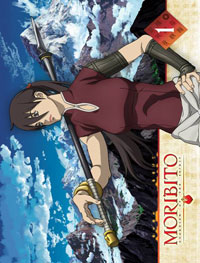
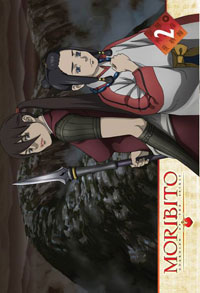
Anime Spotlight: Moribito: Guardian of The Spirit Volumes 1 and 2 Released by Media Blasters' Anime Works
If you're selective about the anime that you watch, make sure to check out Moribito. I'm not going to stop there... Moribito reaffirms the reasons to love anime. In last week's Claymore review, I commented on the place for fantasy anime now that video games loom large on the media-scape, saying "given the sort of virtual world that a current-gen video game can create, a fantasy anime has to distinguish itself by the depth of its characters and the artfulness of its direction." The appeal of Moribito intersects but does not entirely overlap the appeal of Claymore. Based on the first seven episodes of Moribito, I'd forecast that the series does not offer episodic action throughout. There have been episodes of planning or intrigue and there have been episodes that are chiefly sequences of moments driven by the relationship between characters. Beyond that, Moribito looks to have positioned itself in such a way that the conflict is not on a path to be settle strictly by the art of war. That said, the first episode literally dives into the action. Stunts don't come easy in anime. Physics and medicine have been defied far too often to credit a jump from a bridge into river rapids as a potentially life threatening exercise. In this case, the determination conveyed by the jumper's character animation, the scale of the river and the objects floating down it and the impression that a small miscalculation or break of bad luck could be fatal, all contribute to allow the moment to supersede the rational notion that no one is in danger in an animated stunt. Looking slightly ahead, episode three features one of the most amazing fights that I've seen animated as a spear woman contends with four swordsmen. Thinking back to other great anime melees, many of the ones that I can think of were simplified in some respect. The fights were brief or the characters were falling back on repetitious tactics. In contrast, this engagement is sustained and dynamic. Rather than an exchange of specific moves and flourishes, this fight is actually choreographed. With participants reacting to the attacks and the terrain by the instant, the row evolves so quickly that its participants appear to be moving as much on instincts and cunning as anything else. It's almost at the speed of quick cut editing, without the obscuring focus that usually accompanies that style. At the same time, the direction is intricately considered, capturing the details from the weight of a stance to the bend of a spear, and positioning the point of view between subjective shots and a full action vantage at the best angle to reflect the character and spirit of the battle.I don't think Moribito is planning on a fight every episode, or every other episode, or maybe even every third episode. I don't want to mislead anyone by saying Moribito is the season's great fantasy action anime. I'm not sure that "action" belongs in the description, but when I said that anime could distinguish itself from fantasy in other media by the depth of its characters and the artfulness of its direction, I was referring to potential that's realized in Moribito. Production I.G is a studio with a history of creating experimental works, whether it's been their trials with digital animation in Blood: The Last Vampire or their attempts at creating 3D environments in Heian period piece Kai Doh Maru. Building off theses developmental pieces, as well as their successes, has made Production I.G a particularly fascinating, vital source of anime. I remember saying that Production I.G's Enlightenment age supernatural swashbuckler Chevalier d'Eon was "too ambitious for everything to succeed flawlessly." Moribito is no less ambitious, but it does look close to flawless. Moribito sees Kenji Kamiyama move on from his branch of Shirow Masamune's Ghost in the Shell in the Stand Alone Complex anime to an adaptation of the first entry in Nahoko Uehashi's "Guardian" novel series. It's a move from one creator of intricately designed world to another. Both a doctor of cultural anthropology and an anime fan, Uehashi projects an elemental premise onto a richly complex environment. With 20th Century Boys, Pluto and now Moribito, we've hit a run of truly "adult" protagonists. The moribito - "guardian" of the title is Balsa. As a child, eight people lost their lives so that she could live. Raised by a spear man, she acquired mastery of her guardian's weapon, and applied that skill to serving as a body guard for hire with the ulterior motive of saving a quantity of lives to off-set those who died for her sake. The character is from Kanbal, a land poor in natural resources or arable land, but with open tracts for raising horses. Episode one finds Balsa crossing the mountains into the richer Yogo Empire, ostensibly to have her spear fixed. Balsa enters into a telling conversation with a peddler who she passes on the road. We learn that, about to hit 30 years old, the character is not feeling especially young. When the peddler says that she can get her spear fixed in Yogo, or just about anything else if she has the money, Balsa notes that life is the same wherever you go, if you have the money. If you don't, that's when you have to adapt. However, there is something interesting about living that way. Guardian of The Spirit sees Balsa hired to protect a prince from a sacrificial death at the hands of his father. The whole truth has not been laid out to any party or the viewer, but it is evident that few if any in this conflict are entirely selfish or selfless. People in authority and people with responsibility in this anime are not dummies. This means that Balsa must contend with royalty, intellectuals and martial field agents who might be faced with confusion but rationally attempt to plan and outthink her. It also means, that she must reconcile her obligation to protect the prince with the real possibility that preserving the prince's life may have disastrous consequences. (There are fantastic elements to the anime after all) This interplay points to what is compelling about Balsa, and distinctive among anime protagonists. Anime has calmed down a bit in this respect, but for a while every anime hero seemed to have been defined by a single event in their history. Balsa has that defining event, but she's also lived her life and been shaped by those experiences. Without being a reductionist zealot, she maintains a moral code. Without being humorless or ascetic, she's serious. Without being aided by script cheats, she is able to think around opponents. The compelling qualities of Balsa's character and the effecting qualities of the action are examples of how Moribito is a holistically "right" anime series. To find a place easily, you can have a GPS and turn by turn directions or, if you're in a well planned city, you can figure the route from street signs. Moribito does have exposition, but more often, the answers can be deduced from what the anime shows. At the same time, it does not try to game the audience, and intentionally cofound expectations with "I know that you know that I know..." posturing. Minor spoilers... There is a scene in which Balsa lies in the mud, bleeding from a recently sustained wound. Her haze is broken by the approach of two men who position themselves on either side of her. She gets out a "I know you'd come..." The two launch into a furious duel that puts Balsa's own magnificent spear work to shame. However, there is something about how the mud that splashes on Balsa's face does not stay in place, and how she appears to be zoning out rather than being drawn to try to look at the struggle... As it culminates, you expect Balsa to see a vision of herself watching the ongoings. Sure enough, soon after the fatal blow is struck and Balsa turns her head to look into the face of the fallen, a much younger Balsa comes out of her hiding spot, into the muddy clearing. It's not a "Ha! I figured it out moment." It wasn't supposed to be a trick, and because of the attention to all of the pieces ,a you can guess that the fight was a hallucination before that was revealed. End spoilers The backdrop of Moribito is a marvel, working from this principle that I'll call "rightness." (A simplified way of saying that everything is thought out to the minor details, such that no short cut or poorly conceived facet breaks the illusion). It could be thought of as a fusion of pan Asian influences, from streams of flags across the steps to what looks a bit like Korean court headdress. As amazing as the fights are to look at, an urban eatery or floral growth around a pond can be just as captivating in light Moribito's beautiful animation. If you're tired of overused anime tropes... If you want to see a work that really utilizes the potential of the medium, Moribito is a must. As with Ghost in the Shell Stand Alone Complex, Production I.G and Kenji Kamiyama bring together a deep, painstakingly realized world with rewardingly deep narrative.
Animated Films Submitted For Oscar
The Hollywood Reporter notes that 14 films have been submitted to the Academy of Motion Picture Arts and Sciences for possible Oscar nomination in the best animated feature category. Bolt Delgo Dragon Hunters Fly Me to the Moon Igor Kung Fu Panda Madagascar: Escape 2 Africa $9.99 The Sky Crawlers Sword of the Stranger The Tale of Despereaux Waltz With Bashir WALL-E Dr. Seuss' Horton Hears a Who! Of the list, the works of anime include BONES' (Fullmetal Alchemist, Cowboy Bebop: Knockin' on Heaven's Door) samurai action movie Sword of the Stranger and Mamoru Oshii's aerial war novel adaptation Sky Crawlers With at least eight and less than sixteen submitted, three films maybe nominated the categories. Nominees will be announced on January 22nd.
Astro Boy Movie Jets Forward
The 2009 CG animated Imagi movie has begun making its mark on international markets Astro Boy World notes the movie has been licensed local for distribution to Golden Harvest in Hong Kong, Enlight Pictures in China, and Kadokawa in Japan. Summit Entertainment will be handling the film in North America. Creative Director Felix Ip blogged about the film's AFM standee, Ip also mentioned "The trailer will be shown to public in theater very soon (within this month)." According to Anime News Network, the trailer has been put before DreamWorks' Madagascar Escape 2 Africa and will be added to Disney's Bolt. D3Publisher will be developing Astro Boy games for console and handheld systems, targeted for forth quarter of 2009. ICV2 reports IDW will be producing two Astro Boy comic mini series tied to the film. Current plans include a four-part prequel and a four-part adaptation of the film. Pending approval, the first issue of the prequel miniseries is slated for May 2009. According to IDW Editor in Chief Chris Ryall, the books will be tied to the film, but presentation (manga-style or American, formats, etc.) are yet to be determined according to Ryall. Imagi Studios has announced that Jazwares will be the master toy licensee for the film, joined by licensees American Greetings for greeting cards, stationery, gift wrap, and party goods; Penguin for books; and D3Publisher for game software. Mass market products will focus on six to 14-year-olds. Dark Horse has the classic manga rights in the U.S.; Right Stuf has the classic anime. Toy R Evil collects some media.
Upcoming in Japan
Studio 4C's upcoming WWII Russian front series First Squad Playstion 3 game Valkyria Chronicles will be adapted into an anime series.Hiroshi Takahashi (Worst) wrote yankee (young tough) manga Crow. The manga inspired the Takashi Miike movie Crows Zero. Now, Crows Zero will becoming a new manga by Kenichiro Naito, to run in Weekly Champion Tokyograph reports that Shunsuke Daito and Wakana Matsumoto have been as the leaded in Atsushi Kaneshige's adaptation of blog turned manga "Fujoshi Kanojo." The story following a relationship between a young man and his geeky girlfriend. The movie is scheduled to start filming on the 19th, with theatrical release planned for next spring. Via Anime Nation New sites Asakiymemishi – The Tale of Genji based on Muraski Shikubu's adaptation of the classic novel, directed by Osamu Dezaki Murasaki Shikibu talks about the project here Shinkyoku Soukai Polyphonica S Isekai no Seikishi Monogatari (the Tenchi Muyo spin-off) Viper's Creed Slayers Evolution-R Starchild has launched promo page for a second season of Shikabane Hime titled, Shikabane Hime: Kuro. The anime will run on Japanese TV in January. The titular Shikabane Hime ("Corpse Princess") in Yoshiichi Akahito's original Shikabane Hime manga is Makina Hoshimura, an undead girl who hunts down 108 corpses in order to go to heaven. Director Masahiko Murata has already been adapting the beginning of the manga for the first Shikabane Hime television anime series, which premiered last month. AnimeNation notes that while Gainax is the studio behind the first series, Shikabane Hime Aka, The second series will be animated by Feel (Jinki:Extend, Otoboku, Strait Jacket). Iwa ni Hana reports that Revolutionary Girl Utena's Ikuhara Kunihiko will be working on a new project with the manga artist Nakamura Asumiko. It is called Nokemono to Hanayome. Both Ikuhara's novel version and Nakamura Akumiko's illustrated manga version appear in the magazine KERA More Eva 02 in Evangelion: 2.0 You Can (Not) Advance previews
Cool Figures News
Sideshow Collectables Sideshow has a number of anime-related figures for pre-order Ignis - Blazing Scarlet A Yamato USA 8.65" figure, sculpted by G.O. (Cerberus Project TM), based on the character from visual novel / game Jingai Makyo Available 1st Qtr 2009 for $89.99 Available for pre-order hereRyu Meifen 1:8 scale - Shuraki The latest in the Shuraki line of PVC statues from Good Smile Company, Ryu Meifen. The 9" figure will be available for $74.99 Available for pre-order here 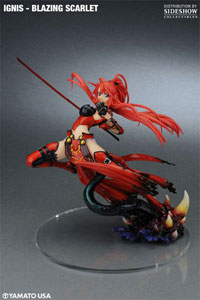
Rize 1:8 scale - Shuraki The 9" figure will be available for $79.99 Available for pre-order here Needa 1:8 scale - Shuraki The 9" figure will be available for $79.99 Available for pre-order here 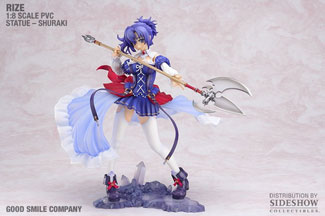
RAH Fist of the North Star - Jagi Medicom Toy Corporation Real Action Hero The 12" figure will be available for $179.99 Available for pre-order here 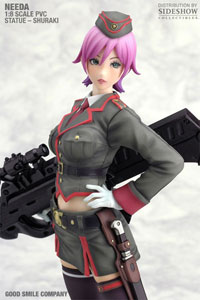
* Go Hero's Buck Rogers Pistols are now shipping to pre-orderers. From the announcement, "when the balance of the guns hit the states, we will change from pre-order to order. "Buck Rogers Figures are now finishing up production. We had a slight delay to make sure we met the RHOS safety standards. Figures are scheduled to ship at the end of this month to arrive in the states next month! Pre-order folks will ship first. The Go Hero Exclusive remote will be included with the pre-order figures. We will begin charging cards when the products are ready to ship. Buck Rogers contests are being launched at Figures.com / One Sixth Warrior - Future Villain Customizing Contest GO
Toys R Evil - "Home-Made Ray-Gun" Contest GO Vinyl Pulse - "In the Future" Art Contest GO* Super7 x Secret Base FrankenBrain will be available at the Super7 store on November 21st. Super7 is joining long-time friends and collaborators Secret Base for a step forward with a nod back. Following in the footsteps of the now classic Secret Base 'Kaiju Spray' releases is the S7 x SB Kaiju Spray FrankenBrain! Combining the body of Super7's Frankenghost with the head (and inner head) of Secret Base's iconic fight figure, the Skull Brain, this blind-packaged release is cast in glow in the dark vinyl with fluorescent pink, green or orange spray.* Toypunks on their volume 2 filming Ishimori ProXPanson Works trading figures, featuring characers from Kamen Rider RX, Kikaider, and Cyborg 009.Weekly Jump's 40th anniversary Dragonball x Blue Dragon trading figures Neat Revoltech Street Fighter edited photo UglyBlog on giants robots Gigarainos and Black Gingaioh Custom TMNT Shredder and Krang * Good stuff from CollectionDXBook Review: Ultimate Guide to GI Joe 1982-1994 Disney Transformers Mickey Mouse? Masterpiece Transformers Grimlock Studio Half-Eye Dangaioh VF100 Messiah Valkyrie VF-25F Alto Saotome DX Chogokin Macross F Michel and Luca Messiah Valkyries Super Robot Wars OG SRG-03-2 Grungust model kit from Kotobukiya GeGeGe no Kitaro KHakaba Oyaji from Secret Base * In other merch new, Right Stuf has announced the upcoming release of new t-shirts. Gravitation T-Shirt: Shuichi & Eiri w/Logo - White available now MSRP: $16.99 (XXL $18.99) Available in sizes S-XXL Regular fit; 6.1 ounce, 100% pre-shrunk cotton - Small: Catalog #: 5535S - Medium: Catalog #: 5535M - Large: Catalog #: 5535L - XL: Catalog #: 5535X - XXL: Catalog #: 5535XXGravitation © 2000 Maki Murakami/Sony Magazines Inc/Aniplex Inc. © Maki Murakami/GENTOSHA COMICS INC. Produced under license by Nozomi Entertainment. © 2008 Nozomi Entertainment. Ninja Nonsense T-Shirt: Excitement - Gray Pre-Book: 1/27/2009 Street Date: 2/24/2009 MSRP: $16.99 (XXL $18.99) Available in sizes S-XXL Regular fit; 6.1 ounce, 100% pre-shrunk cotton - Small: Catalog #: 5532S - Medium: Catalog #: 5532M - Large: Catalog #: 5532L - XL: Catalog #: 5532X - XXL: Catalog #: 5532XX Ninja Nonsense © 2004 Ryoichi Koga / MediaWorks / Ninin ga Shinobuden Production Committee. Produced under license by Nozomi Entertainment. © 2008 Nozomi Entertainment. Ninja Nonsense T-Shirt: Onsokumaru – Red Pre-Book: 1/27/2009 Street Date: 2/24/2009 MSRP: $16.99 (XXL $18.99) Available in sizes S-XXL Regular fit; 6.1 ounce, 100% pre-shrunk cotton - Small: Catalog #: 5533S - Medium: Catalog #: 5533M - Large: Catalog #: 5533L - XL: Catalog #: 5533X - XXL: Catalog #: 5533XX Ninja Nonsense © 2004 Ryoichi Koga / MediaWorks / Ninin ga Shinobuden Production Committee. Produced under license by Nozomi Entertainment. © 2008 Nozomi Entertainment.
Upcoming North American Releases
ADV Films via Anime on DVD 01-06-2009 Eden's Bowy Complete Collection - 650 mins - $39.98 Martian Successor Nadesico: Prince of Darkness Movie - 90 mins - $19.98 1-13-2009 Mahoromatic Collection - 325 mins - $44.98 Megazone 23 Complete Collection - 255 mins - $29.98 Saint Seiya Collection 1 - 750 mins - $39.98 Wedding Peach Season 2 Collection - 700 mins - $39.98 01-20-2009 Kiba Collection 1 - 650 mins - $49.98 Legend of Lyon: Flare - 60 mins - $29.98 Magical Shopping Arcade Abenobashi Complete Collection - 325 mins - $49.98 Tsukihime Collection - 300 mins - $44.98 01-27-2009 Panyo Panyo Di Gi Charat Complete Collection - 350 mins - $49.98 Aurora ICV2 reports that Aurora Publishing is planning to release two new josei/shojo fantasy manga during the first quarter of 2009. Tengu-jin by Sumomo Yumeka is planned for FebruaryQueen of Ragtonia is a two volume series, Chika Shioma, will be released starting in March. Bandai Entertainment Via ToonZone 1/06/09 Gurren Lagann Part 2 Gurren Lagann vol. 3 & 4 Lucky Star vol. 5 1/13/09 Ghost in the Shell 2: Innocence Ghost in the Shell 2: Innocence (Blu-ray) Gundam SEED Destiny TV Movie 4 Gundam SEED Destiny Collection 1 (Anime Legends) Via Anime on DVD, Bandai delays include Ghost Slayers Ayashi Part 1 LE Old Release Date: 12.02.2008 New Release Date: 02.03.2009 Ghost Slayers Ayashi Part 1 Old Release Date: 12.02.2008 New Release Date: 02.03.2009 Clamp School Detectives Complete Collection Old Release Date: 12.02.2008 New Release Date: 02.03.2009 Code Geass Lelouch of the Rebellion Part 2 LE Old Release Date: 12.02.2008 New Release Date: 12.09.2008 Code Geass Lelouch of the Rebellion Part 2 Old Release Date: 12.02.2008 New Release Date: 12.09.2008 Code Geass Lelouch of the Rebellion Vol.3 Old Release Date: 12.02.2008 New Release Date: 12.09.2008 Code Geass Lelouch of the Rebellion Vol.4 Old Release Date: 12.02.2008 New Release Date: 12.09.2008 Lucky Star Vol.4 Old Release Date: 11.04.2008 New Release Date: 11.18.2008 Lucky Star Vol.4 LE Old Release Date: 11.04.2008 New Release Date: 11.18.2008 Dark Horse DAWN: THE WORLDS OF FINAL FANTASY Yoshitaka Amano (A) On sale Apr 15 FC, 116 pages $29.95 HC, 8 1/4" x 11 11/16" There is only one Final Fantasy. Through more than a dozen wildly diverse adventures, from the release of the first game in 1987 to the most recent expansion on the story, the international influence of the game is legendary both inside the video-game industry and throughout popular culture. It is a tale of bold heroes and heroines, breathtaking landscapes and terrifying creatures. Through Final Fantasy, Luneth, Refia, Rosa Farrell, Cecil Harvey, and many others have become household names to millions of players across the globe. With two feature films, a host of action figures and apparel, posters, soundtracks, and more, the vast landscape defined by the Final Fantasy storylines began with the games. For the first six games those worlds grew from the remarkable vision of one man: Yoshitaka Amano. Now, for the first time outside Japan, Amano and Square Enix, Inc., have permitted the artwork that inspired the designs of the Final Fantasy games to be published. In Dawn you will see the development of the first four games through Amano's paintings, detailed line art, and preliminary sketches. Plus, in a special afterword, you'll learn the genesis of this history-making collaboration. GANTZ VOLUME 5 Hiroya Oku (W/A) On sale Apr 29 b&w, 228 pages $12.95 TPB, 5 1/8" x 7 1/16" Strange bird aliens inside the bodies of 1970s pop stars. Memories of dead aliens who stunk of onions. Suicidal girls with massive boobs. A friend who idolizes him, yet beats up the biggest bullies and gets the girl. Life is complicated for Kei Kurono. So far, he's had to deal with sleeping next to a sad but excessively cute and endowed girl who asked to be his "pet"; the fact that he's apparently really a fax copy of himself--the real version having died in the first volume and falling out of the sky after being dropped by some sort of alien eagle. Hiroya Oku created a crazy-popular manga and anime with Gantz, and Dark Horse Comics is more than happy to bring you what might be Japan's weirdest and sexiest sci-fi series ever. GHOST TALKER'S DAYDREAM VOLUME 4 Saki Okuse (W) and Sankichi Meguro (A) On sale Apr 8 b&w, 216 pages $10.95 TPB, 5" x 7" OH MY GODDESS! VOLUME 32 Kosuke Fujishima (W/A) On sale Apr 29 b&w, 144 pages $10.95 TPB, 5 1/8" x 7 3/16" PATH OF THE ASSASSIN VOLUME 15: BAD BLOOD Kazuo Koike (W) and Goseki Kojima (A) On sale Apr 29 B&w, 304 pages $9.95 TPB, 4 x 6 Final volume TRIGUN MAXIMUM VOLUME 14: MIND GAMES Yasuhiro Nightow (W/A) On sale Apr 8 b&w, 272 pages $9.95 TPB, 5" x 7" Final volume FUNimation Via Robert's Anime Corner Blog FUNimation has delayed a number of releases: Glass Fleet DVD Boxed Set - Dec 30th to Jan 13th Magical Girl Lyrical Nanoha DVD Boxed Set - Nov 11th to Dec 9th Samurai 7 BluRay Box - Dec 9 to Jan 20th Anime on DVD is pieces together clues to a possible Darker than Black Blu-ray release here Media Blasters Anime 1/6/2009 TWEENY WITCHES The Adventures (Adventures 1-12 * 2 Discs * $24.99) 1/13/2009 VOLTRON Vol. 7 (Volume 7 of 8, Eps. 91-108 * 3 Discs * $34.99) 1/27/2009 AH MY BUDDHA - The Aroused One (Volume 1 of 6, Eps. 1-4) DOUJIN WORK - Pencil And Paper (Volume 1 of 3) 2/17/09 NIGHT HEAD GENESIS - Disturbance (Volume 3 of 5, Eps. 11-15) 2/29/09 MORIBITO - Guardian Of The Spirit - Volume 3 of 8 (Eps. 8-10) AH MY BUDDHA Ikkou is your everyday teenage boy with everyday teenage desires. Too bad he's training to be a priest in a Buddhist temple full of incredibly gorgeous and obviously available priestesses. The temple is usually called on to perform exorcisms, and Ikkou's inner power is on hand for whenever things get out of control. A little flash of skin (usually a lot) from his female colleagues is enough to supercharge him, but the aftermath involves dealing with an extra turned-on priest whose loins were blazing to begin with. It's enough to make anyone cry out for Buddha to save them. Doujinwork Doujin Work follows the life of a young girl named Najimi Osana and her exposure into the doujin world. She was first tempted into becoming a doujin artist after seeing how much one of her friends can make at a convention. Najimi loves to draw, though soon learns, contrary to what she expected, that this new world is anything but easy. As she attends more conventions and meets more people, Najimi eventually manages to find a group of very interesting friends. These friends already have some experience in the field and help her out along the way so that she can someday make a name for herself creating doujinshi. TWEENY WITCHES The Adventures The destinies of Arusu, Sheila, and Eva have reached their individual conclusions, but many of their adventures in the Magical Realm still remain untold. Rejoin the trio of apprentice witches in wonderland as they experiment with ancient spells, face a powerful witch and her looking-glass self, and find a legendary fairy. The origin of Dragon House, the grand master's past, and a fun romp with Atelia's subordinates Mileth and Miletis are also explored in these charming side stories. The story strays off the beaten path in this companion piece to the Tweeny Witches series, diving into things that will leave a smile on your face and a tear in your eye. Manga 1/21/2009 FUJOSHI RUMI - Volume 3 AKIHABARA@DEEP - Volume 2 2/25/09 DOUJIN WORK Pencil and Paper - Volume 1 of 3 Japanese Live Action 1/13/2009 TOKYO GORE POLICE 1/27/2009 KISARAZU CAT’S EYE II - The Movie DEATH TRANCE (Blu-ray) 2/03/09 LONE WOLF AND CUB TV - Volume 6, Eps. 23-26 (2 Discs) 2/24/09 ONE MISSED CALL III TOKYO GORE POLICE In the near future, the Tokyo Police Corporation is locked in a bloody war with the "engineers." These genetically modified super-criminals can bio-fuse their open wounds with weapons, turning self-mutilation into a combat form. Ruka, the daughter of the police chief's murdered right-hand man, is now the top engineer hunter. With cold-blooded efficiency she cuts through the psychotic engineers and tracks down their home base, a truly bizarre fetish club. Nothing keeps her from her sworn duty, even when she finds out the truth behind her father's death. Right Stuf Right Stuf's MARIA

